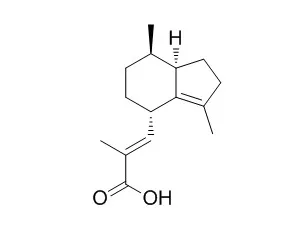| In vitro: |
| Neuropharmacology, 2007, 53(1):178-187. | | Valerenic acid potentiates and inhibits GABAA receptors: Molecular mechanism and subunit specificity.[Reference: WebLink] | Valerian is a commonly used herbal medicinal product for the treatment of anxiety and insomnia.
METHODS AND RESULTS:
Here we report the stimulation of chloride currents through GABAA receptors (IGABA) by Valerenic acid (VA), a constituent of Valerian. To analyse the molecular basis of VA action, we expressed GABAA receptors with 13 different subunit compositions in Xenopus oocytes and measured IGABA using the two-microelectrode voltage-clamp technique. We report a subtype-dependent stimulation of IGABA by VA. Only channels incorporating β2 or β3 subunits were stimulated by VA. Replacing β2/3 by β1 drastically reduced the sensitivity of the resulting GABAA channels. The stimulatory effect of VA on α1β2 receptors was substantially reduced by the point mutation β2N265S (known to inhibit loreclezole action). Mutating the corresponding residue of β1 (β1S290N) induced VA sensitivity in α1β1S290N comparable to α1β2 receptors. Modulation of IGABA was not significantly dependent on incorporation of α1, α2, α3 or α5 subunits. VA displayed a significantly lower efficiency on channels incorporating α4 subunits. IGABA modulation by VA was not γ subunit dependent and not inhibited by flumazenil (1 μM). VA shifted the GABA concentration–effect curve towards lower GABA concentrations and elicited substantial currents through GABAA channels at ≥30 μM. At higher concentrations (≥100 μM), VA and acetoxy-VA inhibit IGABA. A possible open channel block mechanism is discussed.
CONCLUSIONS:
In summary, VA was identified as a subunit specific allosteric modulator of GABAA receptors that is likely to interact with the loreclezole binding pocket. | | Neuropharmacology, 2007, 53(1):178-187. | | Valerenic acid potentiates and inhibits GABAA receptors: Molecular mechanism and subunit specificity.[Reference: WebLink] | Valeriana jatamansi Jones, commonly known as Indian Valerian or Tagar (Family: Valerinaceae) is used in both traditional and modern systems of medicine. The plants of this species are known for their high content of Valerenic acid, the main active constituent of valerian, and high antioxidant activity, and these characteristics have increased the demand for these plants by the pharmaceutical industry. At present, the demand for planting material is largely met from the harvesting of wild plants, which vary in quality and quantity of the active ingredient.
METHODS AND RESULTS:
Therefore, there is a need to identify individual plants/populations with a higher content of the active ingredients and higher antioxidant activity. We used inter-simple sequence repeats (ISSR) markers in 151 genotypes of 25 V. jatamansi populations to identify markers associated with Valerenic acid and antioxidant activity. Of the 130 ISSR primers tested, 20 generated 159 bands, with an average of 7.95 bands per primer. Valerenic acid content was significantly (p < 0.05) higher in the Katarmal (aerial portion 0.57 ± 0.04 %) and Joshimath populations (root portion 1.80 ± 0.12 %). Antioxidant activity using these different in vitro assays varied among the populations and plant portions, with maximum antioxidant activity found in the aerial plant portion (8.63 ± 0.06 mM) and roots [8.36 ± 0.0 mM ascorbic acid equivalents (AAE)/100 g dry weight (dw)] of the Didihat and Katarmal populations, respectively, using the ABTS [2, 2′-azino-bis(3-ethylbenzothiazoline-6-sulphonic)] assay. The DPPH (2, 2-diphenyl-1-picryylhydrazyl free radical scavenging) assay revealed maximum antioxidant activity in the aerial plant portion (15.23 ± 0.09 mM) and roots (17.53 ± 0.04 mM AAE/100 g dw) of the Didihat population. The FRAP (ferric-reducing antioxidant power) assay showed that the roots of plants of the Ukhimath population had significantly higher antioxidant activity (12.71 ± 0.04 mM AAE/100 g dw) than those of other populations of V. jatamansi.
CONCLUSIONS:
Based on the stepwise multiple regression analysis, seven positive and six negative markers showed significant association with Valerenic acid content. Antioxidant activity measured by the ABTS, DPPH and FRAP assays showed a positive correlation with 14, 13 and 10 markers, respectively (p < 0.001).
These markers have the potential for application in breeding programmes in order to select lineages of V. jatamansi with higher biochemical attributes, especially when no other genetic information, such as linkage maps and quantitative trait loci is available. |
|






 Cell. 2018 Jan 11;172(1-2):249-261.e12. doi: 10.1016/j.cell.2017.12.019.IF=36.216(2019)
Cell. 2018 Jan 11;172(1-2):249-261.e12. doi: 10.1016/j.cell.2017.12.019.IF=36.216(2019) Cell Metab. 2020 Mar 3;31(3):534-548.e5. doi: 10.1016/j.cmet.2020.01.002.IF=22.415(2019)
Cell Metab. 2020 Mar 3;31(3):534-548.e5. doi: 10.1016/j.cmet.2020.01.002.IF=22.415(2019) Mol Cell. 2017 Nov 16;68(4):673-685.e6. doi: 10.1016/j.molcel.2017.10.022.IF=14.548(2019)
Mol Cell. 2017 Nov 16;68(4):673-685.e6. doi: 10.1016/j.molcel.2017.10.022.IF=14.548(2019)